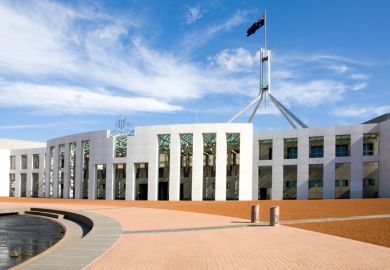In the run-up to his 2013 general election victory, the leader of the Australian opposition, Tony Abbott, declared that his party would exercise “masterly inactivity” when it came to universities. Four years on, nothing has changed in policy terms, but there has been much activity – little of it masterly.
Determined to record a budget surplus by 2021, the Liberal-National government has had two goes at overhauling university funding. The first, under Christopher Pyne’s tenure as education minister, accepted universities’ argument that they needed more revenue to educate and research well. It proposed allowing them to charge students as much as needed in exchange for accepting a 20 per cent cut in public funding. The government would save, universities would have more revenue, and students would, in theory, get better outcomes.
Fears of “$100,000 degrees” sank that package. The uncertainty about how high tuition fees would rise was too much for crucial senators.
The second package – under a new education minister, Simon Birmingham, and a new prime minister, Malcolm Turnbull – reversed the logic of the first. The government now argued that universities were doing well, and thus needed less revenue and could cope with a 5 per cent cut by being even more wonderfully efficient. The maximum student charges would rise by 7.5 per cent, with government funding falling by the same amount. But the key Senate group, the Nick Xenophon Team of independents, once again rejected the package amid university-led argument that “students will pay more for less”.
So where does the government go from here?
Neither reform package challenged the demand-led admissions system introduced in 2012. Implicit in that system is a recognition that a post-secondary qualification, whether from higher or vocational education, is needed. A degree is no longer a guarantee of future wealth; rather, not having one puts you at great risk of future poverty. No parliamentarian wants to tell constituents that their children should not have access to university.
However, if everyone is to access tertiary education, how is it to be resourced? Australia’s income-contingent student loans system has worked well to generate significant funds and reduce the upfront costs of higher education. It may be that we have pushed it as far as it can go. The higher the charge, the longer graduates will be repaying once they join the workforce and the less likely they will be to repay it in full.
The old assumption that university students do not matter politically is challenged. University debt is now common, and higher charges are a political negative that echoes the resistance to fees elsewhere in the world – including in New Zealand, whose new government has pledged to abolish them.
The Australian government has now to indicate its position in response to the Xenophon Team’s rejection of its latest plan.
Without a vote, the legislation remains alive until the government declares otherwise. The looming date is the mid-year budget update that will be released late in December. The government either concedes that the package is lost, perhaps announcing other changes – or, as it did after the first defeat of Pyne’s package – pretends that eventually all will be passed. With key changes scheduled to commence from January 2018, the latter looks foolish, but remains possible.
Universities are also focused on every rumour of what the government could do without a change in legislation. The major programmes controlled by the minister are the Higher Education Participation and Partnerships Program, which is aimed at supporting students from deprived backgrounds, and research funding. The government also has some powers to freeze funding at the level of the year before, and to reimpose caps on funded places.
But are such measures plausible? The government’s argument that the future is based on innovation would look weak set against a major slashing of research funding. And freezing university funding is a temporary option that would need an end point.
The Xenophon Team advocates a review of all tertiary education. There is much to be said for such a search for greater clarity, but it would mean stasis for two years. For universities, that is a bearable outcome, but, for the government, it defers yet again resetting university funding.
Conor King is executive director of the Innovative Research Universities mission group.
POSTSCRIPT:
Print headline: Cuts, blood, but still no cure
Register to continue
Why register?
- Registration is free and only takes a moment
- Once registered, you can read 3 articles a month
- Sign up for our newsletter
Subscribe
Or subscribe for unlimited access to:
- Unlimited access to news, views, insights & reviews
- Digital editions
- Digital access to THE’s university and college rankings analysis
Already registered or a current subscriber? Login





